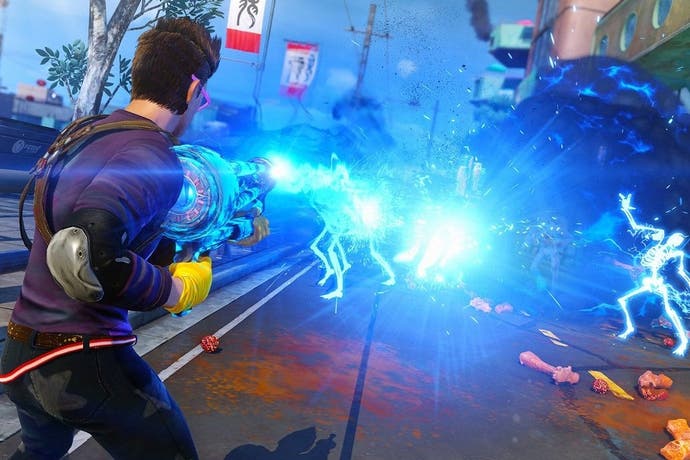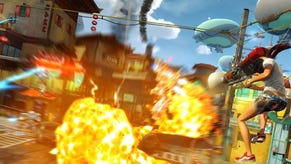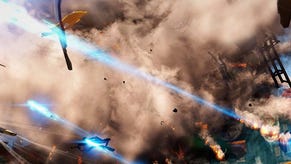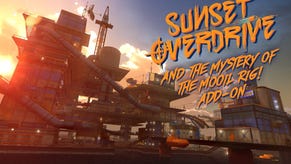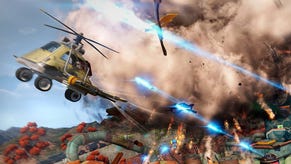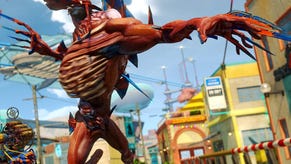Sunset Overdrive: the Ted Price interview
How Insomniac hopes to "retrain" veteran shooter fans.
Xbox One exclusive Sunset Overdrive is a little different. It's a shooter, but instead of firing realistic weapons from behind the safety of a waist-high wall, you're firing harpoons from a gun called Captain Ahab while grinding rails. This is a game where you have to keep moving to survive, not play whack-a-mole against enemies who conveniently poke their heads out of cover every few seconds. It rekindles memories of Jet Set Radio, that fantastic, much-loved Sega classic. Play it for five minutes and you'll see why.
At EGX this week Ted Price, the boss of developer Insomniac Games, sat down with Eurogamer to reveal why the studio wanted to do something different with the shooter genre after shipping gritty PlayStation 3 exclusive FPS Resistance 3 in 2011. There were a few bumps along the road to Sunset Overdrive's upcoming October 2014 launch, but it sounds like a fascinating journey.
Oh, and we asked a few questions from Eurogamer's dear readers, too (like, will Sunset Overdrive come to PC?). You lot really are lovely.
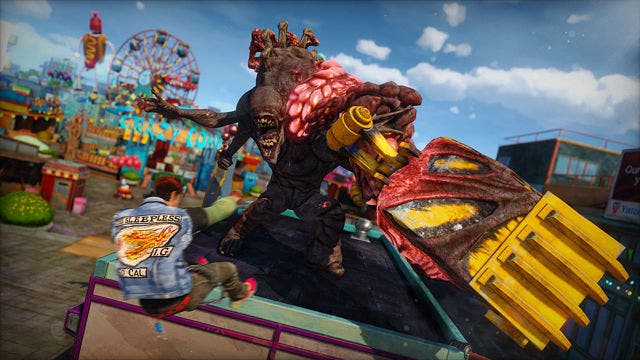
Sunset Overdrive has zombies. What makes them interesting to fight? What's different about the enemies in this game compared to the zombies we've seen in other games?
Ted Price: First of all, it's not just the OD'd. OD'd are the Overcharged Delirium drinkers. They're the ones we showed first. They're the mutated humans who have drunk too much Overcharge. They come in a lot of different forms. It depends on what they were doing when they were drinking Overcharge. Sometimes they are these large Herkers with big shovel hands. Sometimes they're the flying Wingers that spew fire. There are several other types.
These are not zombies. These are mutants. And they move very quickly. They work well together. They are intensely interested in getting their hands on more Overcharge. So what's fun in the game is you can distract them with Overcharge, if you for example use the Captain Ahab, which is one of our crazy weapons. It's a harpoon gun where you've got a can of Overcharge attached. You fire that and big puddles of Overcharge spill and the OD'd are drawn like flies to these puddles. But if you let them drink too long, they change into Poppers, which are these further mutated OD'd. So there are different levels of complexity we introduce with these guys that make them very different from your traditional zombies.
But then you've got the Scabs, which are the human enemies in the game, who use a completely different set of strategies. And you've got the FizzCo forces that you see later in the game, that are robotic. You have to use different strategies against them.
Of the three main enemy types, what's the split in the game?
Ted Price: It's a big world and there are a lot of enemies. It's not quite an even split, but it's close to a third, a third, and a third in terms of the enemy families you'll see in the game. It depends on the areas you're entering, because there are a lot of different areas in the game, and lots of quests and missions you go on. Some of those quests are focused more on FizzCo enemies. Some of them are more focused on the OD'd. Some are all about the Scabs. It all depends.
So there is a lot of variety. One of the key elements for us in all of our games is to present players with variety, whether it's variety within enemy families, or variety of weapons, or variety of moves you can perform. As you're moving through the game, we're continuing to introduce new elements, whether it's weapons, amps, enemies or story elements, to keep players excited about exploring this very large open world.
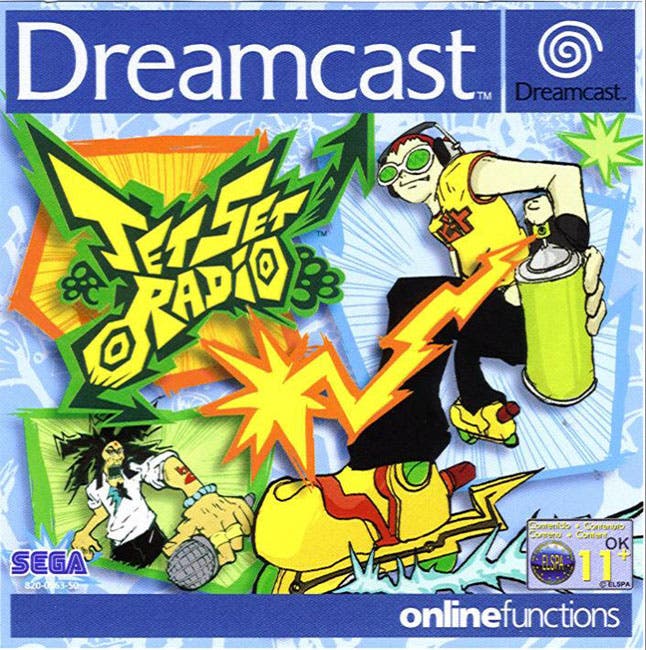
How much of an influence was Jet Set Radio?
Ted Price: Jet Set Radio and Tony Hawk in particular were influential when we began experimenting with our traversal. During pre-production we had a strong desire to move away from a traditional shooter mechanic. We've all been playing games for years where we've hidden behind cover and then kind of scuttled to the next concrete barrier. We wanted to change that up. And Jet Set Radio and Tony Hawk came up, because our two creative directors are big fans of Tony Hawk. One of our designers, Cameron Christian, is a fan of Jet Set Radio. This idea of grinding on rails and grinding on wires and bouncing on cars started gaining traction at the studio.
At first it didn't work. We were a little worried about how it would possibly work with combat. But after lots of experimentation it did. Then, even though Jet Set Radio and Tony Hawk were influences, we started getting external questions about it. People were saying, oh, I see Jet Set Radio in this. It's flattering, to be perfectly honest.
How has the development of Sunset Overdrive differed from the development of your recent games?
Ted Price: One, this is our first open-world game. So we've had to take a very different approach to design and layout. The second big difference is because of the traversal options you have in the game - grinding, vaulting, bouncing and wall-running - we've had to be meticulous about placement for our buildings. For you as a player to have fun chaining moves together, we spend a lot of time making sure you can chain things together without feeling there's something off.
So, you'll find as you're playing, moving through the city can be a very fluid experience. That's because the designers and the environment artists spend a lot of time with metrics and making sure everything is placed just right.
Sunset Overdrive your first open-world game. Has it required more time to develop as a result than your previous games?
Ted Price: It's been a bigger effort for sure. We have the largest team we've ever put on any of our projects, and we also have brand new tools and an engine we built specifically to prepare for the new generation. These tools have enabled us to build much more quickly, and that's important for a game as large as Sunset Overdrive.
I imagine you've learnt a lot while making this game, given how different it is compared to what you've done before.
Ted Price: Yeah. And that doesn't go for just world layout. It goes for storytelling, the weapons, the progression systems, the crafting - those are all elements of course we have experience in, but we took each one of those systems in a different direction for Sunset Overdrive.
And for us it's fun, because learning is great. None of us want to stagnate when it comes to game development. We always want to push ourselves and do something new. The fans demand it. You have to have fresh experiences or you won't stand out and fans will look elsewhere.

Was that a part of the motivation for making a game that was unlike the shooters from behind cover you were describing before?
Ted Price: Yeah. That motivation wasn't completely apparent at the very beginning, because when Drew and Marcus, the creative director and game director, presented the initial concept, it was about presenting a different tone and a different style. But then very quickly when we started discussing game mechanics, we also realised it was important to take a step in a new direction for shooters.
For the last decade we've all been playing similar shooters, and we felt there was an opportunity, especially on the new-gen, to present a new paradigm. But, as I said earlier, it took a lot of trial and error to figure out how to make it work. It wasn't easy. And you'll find playing the game, if you are an avid shooter player, we retrain you on how to actually approach this new type of shooter. We encourage players in a lot of ways to get up off the ground and move fast.
Can you give me an example of how the game actually retrains shooter fans?
Ted Price: There are two specific mechanics we use. You asked about the enemies earlier. These enemies are very fast. If you are on the ground they will swarm you and they will take you apart. That's one incentive to get up and move, bounce, grind, wall-run.
The other one is we have something called the style system. As you are grinding and bouncing and killing enemies while you're moving with agility through the city, you're building up style. The reason that's important is because as you build up more and more style, you activate amps. Amps are the crafted power-ups we have in the game, which affect your hero abilities, your melee, and your weapons. We also have these epic amps that will be triggered after you hit the third style level.
But it's really rewarding and useful to start having these amps go off, because it makes you more effective in combat. But you can only do that if you're being agile.
So the game not so subtly rewards you for moving around.
Ted Price: Yeah. But the third thing we spent a lot of time on was just making sure the controls were responsive. When you're in a fast-moving game, control is key. Camera control, character control, making sure the transitions between the various acrobatic moves are fluid. That was incredibly important to us. We have a heritage with Ratchet in particular, of creating high action but well-controlled characters.
It must be quite nerve-racking creating a new IP that's trying to do shooters a little differently at a time when games cost so much to make and there is so much risk-aversion among publishers. Were you nervous about the reception?
Every development is tough. I'm sure you hear this from all the developers you talk to. Every new IP is a nail-biting experience. But the one thing that kept us optimistic and positive is that this is the kind of game we love making. It speaks to the core of who Insomniac is, because it's got a sense of humour, because it's stylised. It's what we do best.
Insomniac owns the Sunset Overdrive IP. I hear nobody creates a new IP these days without wanting it to be a franchise and blockbuster series. Is that your hope for Sunset Overdrive?
Ted Price: Yeah. That's the obvious answer. But I also hope players enjoy the mechanics we're introducing for shooters, what I feel is a very different approach to moving from an open world and engaging in combat. For all of us that's been an exciting journey to figure out how that can work. It's probably difficult for readers to understand what I'm talking about, because you've got to get your hands and play it and experience it for yourself.
There are gameplay videos out there that help.
Ted Price: There's really no substitute for playing it, especially when you're talking about a game that bucks the trend when it comes to shooter mechanics. I'm excited to see how players respond to our attempt to move shooters in a different direction.
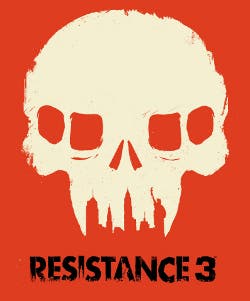
When exactly did you have the idea for Sunset Overdrive?
Ted Price: It was right after we shipped Resistance 3. Drew Murray and Marcus Smith, who were the lead designer and creative director respectively on Resistance 3, had been talking about a very different experience, and a game they felt would really fit our stylistic leanings, and the company's culture best. That resulted in them presenting Sunset Overdrive a few months later.
What was your reaction to the presentation?
Ted Price: I loved it. It was different than what the game is now, but the tone and the style really broke boundaries for us as a company. And I loved the creative risk-taking that Marcus and Drew were proposing. I loved the punk rock aesthetic we started with, and their vision of a game where you could be who you wanted to be. That was part of the very first pitch, where it was important to Drew and Marcus, and eventually to all of us at Insomniac, to present a game where it wasn't about one hero or one heroin. This is a game where you really can be yourself.
Throughout the production, as we figured out how to support multiple ethnicities, multiple genders and multiple body types, and a very large vanity system, it began to feel great. And we knew we had brought that vision Marcus and Drew originally had to life.
You knew from there that they were onto something?
Ted Price: Absolutely. We do a lot of internal pitches. We all have ideas for new games. Some feel right and some don't. This one felt right from the very beginning.
How do you go from that to finding a publisher for the game?
Ted Price: Like most developers we make pitches to publishers. We've had a history in the business so we know a lot of folks. We presented to a number of different groups. And when we presented to Microsoft there was a lot of synergy, because both Insomniac and Microsoft were interested in taking shooters in a different direction.
I remember from the very earliest meetings, we could feel there was a strong connection.
Was Sunset Overdrive always going to be a next-gen console experience, even during the earliest stages?
Ted Price: Yes, we did. The original concept was of an open-world game, and we wanted to bring the same level of detail we provided in our more linear games to an open world, which we knew would be tough to do without moving onto more powerful consoles.
Like all of our games, it evolved along the way. There were certain things that worked and certain things that didn't work. But this game has stayed very true to what we all envisioned at the beginning in terms of style and tone. In terms of mechanics we found our sweet spot relatively early.
Will the game eventually come out on PC?
Ted Price: We're just focusing on Xbox One.
That's not a denial! So what's next for Insomniac? Sunset Overdrive is out soon. Are you rolling into another project or will you take a break?
Ted Price: Like every developer that has multiple teams, we are always busy. I'm sure you've heard we're working on Ratchet & Clank for the PlayStation 4. We are going to release Outernauts on the Android platform. But short-term we are most excited about seeing fan reaction to Sunset Overdrive on Xbox One. It's a brand new IP on a big platform, one that has a lot of fans we know are interested in something different and fresh. The response so far has been fantastic.
